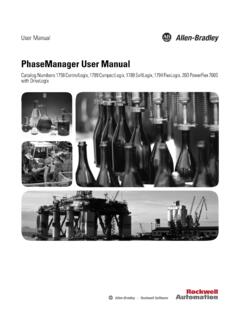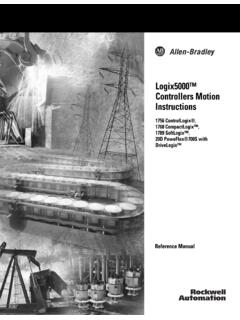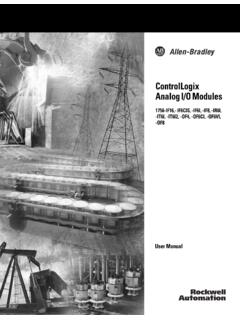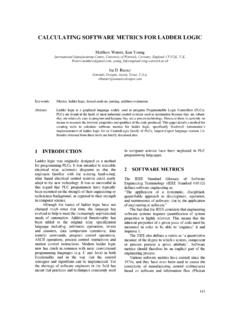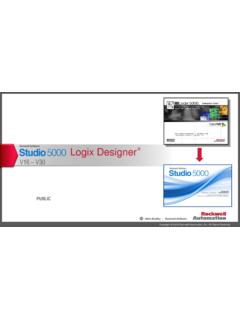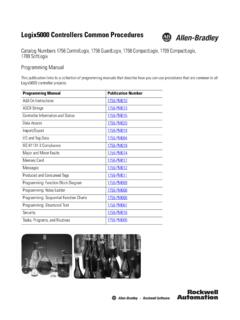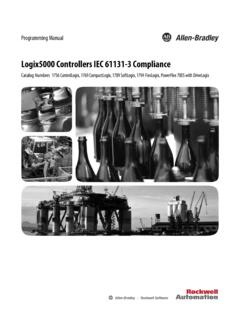Transcription of Logix5000 Controllers Add-On Instructions - etsmtl.ca
1 Logix5000 Controllers Add-On InstructionsCatalog Numbers 1756 ControlLogix, 1756 GuardLogix, 1768 CompactLogix, 1768 Compact GuardLogix, 1769 CompactLogix, 1789 SoftLogix, PowerFlex with DriveLogixProgramming ManualImportant User InformationSolid state equipment has operational characteristics differing from those of electromechanical equipment. Safety Guidelines for the Application, Installation and Maintenance of Solid State Controls (publication available from your local Rockwell Automation sales office or online at ) describes some important differences between solid state equipment and hard-wired electromechanical devices. Because of this difference, and also because of the wide variety of uses for solid state equipment, all persons responsible for applying this equipment must satisfy themselves that each intended application of this equipment is no event will Rockwell Automation, Inc.
2 Be responsible or liable for indirect or consequential damages resulting from the use or application of this examples and diagrams in this manual are included solely for illustrative purposes. Because of the many variables and requirements associated with any particular installation, Rockwell Automation, Inc. cannot assume responsibility or liability for actual use based on the examples and patent liability is assumed by Rockwell Automation, Inc. with respect to use of information, circuits, equipment, or software described in this of the contents of this manual, in whole or in part, without written permission of Rockwell Automation, Inc., is this manual, when necessary, we use notes to make you aware of safety , Rockwell Automation, TechConnect, Logix5000 , ControlLogix, GuardLogix, CompactLogix, SoftLogix, FlexLogix, PowerFlex 700S, and DriveLogix are trademarks of Rockwell Automation, not belonging to Rockwell Automation are property of their respective information about practices or circumstances that can cause an explosion in a hazardous environment, which may lead to personal injury or death, property damage, or economic information that is critical for successful application and understanding of the information about practices or circumstances that can lead to personal injury or death, property damage, or economic loss.
3 Attentions help you identify a hazard, avoid a hazard, and recognize the consequenceSHOCK HAZARDL abels may be on or inside the equipment, for example, a drive or motor, to alert people that dangerous voltage may be HAZARDL abels may be on or inside the equipment, for example, a drive or motor, to alert people that surfaces may reach dangerous 1756-PM010C-EN-P - October 20093 Summary of ChangesThe information below summarizes the changes to this manual since the last help you find new and updated information in this release of the manual, we have included change bars as shown to the right of this Designing Add-On Instructions chapter was divided into two chapters, Designing Add-On Instructions and Defining Add-On Instructions , and some of the content was on high-integrity Add-On Instructions and safety Add-On Instructions was added throughout the manual as well as the changes listed in this of terms10 New Signature Tab for High-integrity and Safety Add-On Instructions16 Restrictions for Safety Add-On Instructions19 Changing the Language Type of the Logic Routine21 Additional Classes Supported by GSV and SSV Instructions26 Create an Alias Parameter for a Local Tag28.
4 38 Designating an InOut Parameter as a Constant31 Defining External Access for Tags31 Updates to Arguments Following Parameter Edits41 Copying Parameter or Local Tag Default Values43 Change the Class of an Add-On Instruction54 Updates to Applying Source Protection procedure58 Generate an Add-On Instruction Signature60 Updated Information on Copying and Pasting Add-On Instructions86 Updated Information on Exporting Add-On Instructions89 Updated Information on Importing Add-On Instructions92 Updated Information on Updating Add-On Instructions via Import954 Publication 1756-PM010C-EN-P - October 2009 Summary of ChangesNotes:5 Publication 1756-PM010C-EN-P - October 20095 Table of ContentsPrefacePurpose of This Manual.. 9 Additional Resources for Safety Applications .. 9 Understanding Terminology.
5 10 Chapter 1 Designing Add-On InstructionsIntroduction .. 11 About Add-On Instructions .. 11 Components of an Add-On Instruction.. 13 General Information.. 13 Parameters.. 14 Local Tags .. 14 Data Type .. 15 Logic Routine .. 15 Optional Scan Mode Routines.. 16 Instruction Signature .. 16 Signature History .. 17 Change History .. 17 Help .. 18 Considerations for Add-On Instructions .. 18 Instruction Functionality.. 18 Encapsulation .. 19 Safety Add-On Instructions .. 19 Instruction Signature .. 20 Safety Instruction Signature .. 21 Programming Languages .. 21 Transitional Instructions .. 21 Instruction Size .. 22 Runtime Editing .. 22 Nesting Add-On Instructions .. 22 Routines Versus Add-On Instructions .. 23 Programmatic Access to Data .. 24 Unavailable Instructions within Add-On Instructions .
6 25 Using GSV and SSV Instructions .. 26 Considerations When Creating Parameters .. 27 Passing Arguments to Parameters by Reference or by Value .. 27 Selecting a Data Type for a Parameter .. 27 Creating an Alias Parameter for a Local Tag .. 28 Using a Single Dimension Array as an InOut Parameter .. 28 Determining Which Parameters to Make Visible or Required .. 29 Using Standard and Safety Tags .. 30 Data Access Control .. 316 Publication 1756-PM010C-EN-P - October 2009 Table of ContentsPlanning Your Add-On Instruction Design .. 32 Intended Behavior .. 32 Parameters.. 32 Naming Conventions .. 32 Source Protection.. 33 Nesting - Reuse Instructions .. 33 Local Tags .. 33 Programming Languages .. 33 Scan Mode Routines.. 34 Test.. 34 Help Documentation .. 34 Chapter 2 Defining Add-On InstructionsIntroduction.
7 35 Create an Add-On Instruction .. 35 Create Parameters .. 37 Create Local Tags .. 39 Edit Parameters and Local Tags .. 41 Updates to Arguments Following Parameter Edits .. 41 Copying Parameter or Local Tag Default Values .. 43 Create Logic for the Add-On Instruction .. 44 Execution Considerations for Add-On Instructions .. 45 Optimizing Performance.. 45 Defining Operation in Different Scan Modes .. 45 Enabling Scan Modes .. 47 Prescan Routine .. 47 Postscan Routine .. 49 EnableInFalse Routine .. 51 Using the EnableIn and EnableOut Parameters .. 52 EnableIn Parameter and Ladder Diagram .. 53 EnableIn Parameter and Function Blocks .. 53 EnableIn Parameter and Structured Text .. 53 Change the Class of an Add-On Instruction .. 54 Testing the Add-On Instruction .. 54 Before You Test.
8 55 Test the Flow.. 55 Monitor Logic with Data Context Views .. 55 Verifying Individual Scan Modes.. 56 Defining Source Protection for an Add-On Instruction .. 57 Enable the Source Protection Feature .. 57 Apply Source Protection.. 58 Observe Source Protection .. 60 Publication 1756-PM010C-EN-P - October 20097 Table of ContentsGenerate an Add-On Instruction Signature .. 60 Generate, Remove, or Copy an Instruction Signature .. 60 Create a Signature History Entry .. 61 Generate a Safety Instruction Signature .. 62 Viewing and Printing the Instruction Signature .. 62 Creating Instruction Help.. 63 Write Clear Descriptions.. 63 Document an Add-On Instruction .. 64 Language Switching .. 67 Motor Starter Instruction Example .. 68 Simulation Instruction Example .. 70 Ladder Diagram Configuration.
9 72 Function Block Diagram Configuration .. 73 Structured Text Configuration .. 73 Chapter 3 Using Add-On InstructionsIntroduction .. 75 Accessing Add-On Instructions .. 75 Use the Add Element Dialog Box.. 76 Include an Add-On Instruction in a Routine .. 77 Tips for Using an Add-On Instruction .. 79 Programmatically Access a Parameter.. 79 Using the Jog Command in Ladder Diagram .. 80 Using the Jog Command In Function Block Diagram .. 81 Using the Jog Command in Structured Text.. 82 Monitor the Value of a Parameter .. 82 View Logic and Monitor with Data Context .. 83 Determine if the Add-On Instruction is Source Protected .. 85 Copy an Add-On Instruction .. 86 Store Your Add-On Instructions .. 87 Chapter 4 import and export Add-On InstructionsIntroduction .. 89 Creating an export File.
10 89 export to Separate Files .. 90 export to a Single File .. 91 Importing an Add-On Instruction .. 92 import Considerations .. 92 import Configuration .. 94 Update an Add-On Instruction to a Newer Revision via import .. 95 Index8 Publication 1756-PM010C-EN-P - October 2009 Table of Contents9 Publication 1756-PM010C-EN-P - October 20099 PrefacePurpose of This ManualThis manual shows how to design, configure, and program Add-On Instructions . This manual is one of a set of related manuals that show common procedures for programming and operating Logix5000 Controllers . For a complete list of common procedures manuals, see the Logix5000 Controllers Common Procedures Programming Manual, publication term Logix5000 controller refers to any controller that is based on the Logix5000 operating system, including the following: CompactLogix and Compact GuardLogix Controllers ControlLogix and GuardLogix Controllers DriveLogix Controllers FlexLogix Controllers SoftLogix5800 controllersAdditional Resources for Safety ApplicationsWith the addition of safety Add-On Instructions in RSLogix 5000 software, version 18, you can use Add-On Instructions in GuardLogix and Compact GuardLogix safety-related functions.
